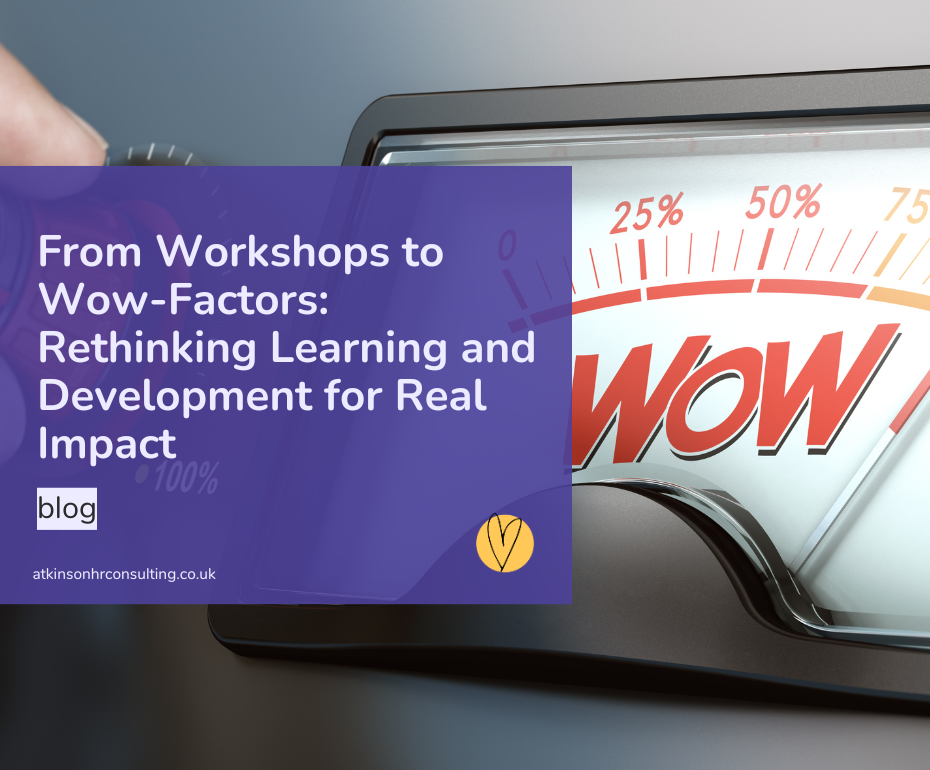From Workshops to Wow-Factors: Rethinking Learning and Development for Real Impact
- Graham Atkinson

- Aug 4
- 4 min read

For many organisations, learning and development (L&D) sits somewhere between a noble intention and an underfunded afterthought.
We want to nurture talent and help our teams grow, but time, budget and capacity often get in the way. The L&D plan ends up being a few ad hoc courses and a LinkedIn Learning login.
But what if we rethought our approach? What if learning wasn’t a ‘nice-to-have’, but a core part of how we deliver our mission?
Why does learning and development matter?
Done well, L&D helps organisations thrive. It’s not just about training courses or ticking boxes. A strategic approach to development supports:
Navigating change and uncertainty
Building leadership capability at all levels
Embedding values and culture across teams
Improving motivation, retention and progression
Responding to evolving skills gaps and sector trends
Crucially, it also helps individuals feel supported in their growth — a key driver of engagement and belonging.
Most organisations are in a constant state of change. Roles evolve. Strategies shift. New tools and ways of working emerge. If we’re not supporting people to learn, we’re asking them to keep pace without the right shoes.
What does a strategic approach to L&D look like?
Moving from one-off training to something more intentional doesn’t have to be complex. A strategic approach means L&D is:
Purposeful – aligned with your organisational goals and future-focused
Planned – with clear roles, priorities, budgets and evaluation
Inclusive – ensuring meaningful access to learning for everyone
Embedded – integrated into everyday work, not just formal sessions
Evaluated – focused on real-world outcomes and long-term impact
It’s about treating learning as a core part of how your organisation works and succeeds — not something squeezed in when things are quiet.
Five practical ways to strengthen your L&D approach
Whether you’re starting from scratch or building on good practice, these five steps can help:
1. Link L&D to your organisational strategy
Start with your goals. What are you trying to achieve — and what knowledge, skills or behaviours will get you there?
If your strategy focuses on digital innovation, inclusion, sustainability or growth, how are you equipping your people to deliver on that?
Make the connection explicit. When staff see how their learning supports the bigger picture, it becomes more relevant and motivating.
2. Make learning a shared responsibility
Creating a learning culture isn’t the job of HR alone. Leaders, managers and teams all play a role.
Leaders should model continuous learning
Managers should have high-quality development conversations
Teams should be encouraged to share knowledge and good practice
If staff regularly sign up to training but don’t attend because of workload, that’s not just a logistics issue — it’s a culture issue.
3. Blend formal and informal learning
Formal courses and e-learning are helpful, but they’re only one part of the picture. Many of the most impactful development opportunities happen on the job — or in the flow of everyday work.
Consider a wider range of learning methods:
Shadowing and mentoring
Stretch assignments and project work
Coaching and reflective practice
Lunch and learns, book clubs and peer learning
Celebrate learning in all its forms — not just certificates or attendance lists.
4. Create clarity and consistency
Unclear processes can stop learning in its tracks. Who approves training? What’s mandatory? How do people access support?
If the answers vary depending on manager or contract type, people may disengage. Instead:
Be transparent about budgets and priorities
Introduce a clear L&D policy
Make access to your core offer simple and consistent
Clear guidance helps people feel confident to take ownership of their development.
5. Invest in systems and structure
The right systems can help scale and sustain learning across your organisation. Think about tools that help you:
Integrate HR and L&D data
Use appraisal insights to identify shared learning needs
Track engagement and impact across teams
Automate processes to reduce admin
Technology can’t create a learning culture on its own, but it can support and amplify one.
How do you know if your L&D is working?
Measuring learning impact is often the missing piece. It’s easy to ask whether people enjoyed a session - but much harder to know whether it made a difference.
Go deeper with your evaluation:
Did the learning change behaviour or practice?
Have people applied what they learned?
Has it improved performance, confidence or collaboration?
Has it helped the team or organisation move forward?
You don’t need complex analytics. Qualitative feedback, reflective conversations, and simple metrics like retention or internal progression can tell you a lot. Engagement survey results can also offer important clues.
If people are telling you they don’t feel able to develop — even when you’ve got a long list of learning options — something isn’t working.
So what?
There’s no single formula for L&D. What works in one organisation might not in another. But one thing is clear:
If you want to build an inclusive, high-performing and future-ready organisation, investing in learning isn’t optional - it’s essential.
If you're ready to build a more strategic and inclusive approach to L&D, we’d love to help. Get in touch to start the conversation.
Don’t miss out on our latest Blogs; sign up for our e-newsletter to receive monthly resources, tips, tools and our latest news here.




Comments